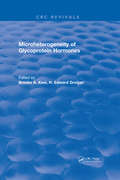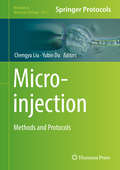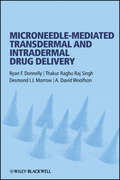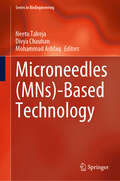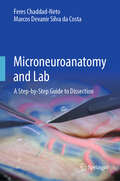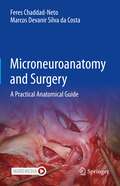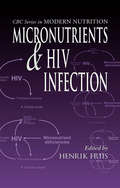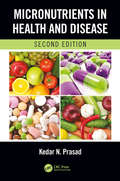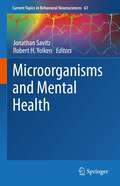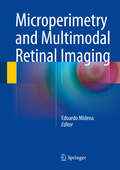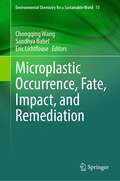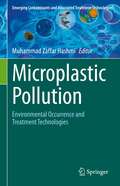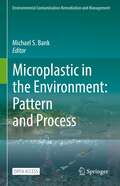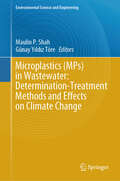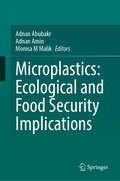- Table View
- List View
Microheterogeneity of Glycoprotein Hormones
by B.A. KeelEleven contributions review our knowledge of the characterization of glycoprotein hormone microheterogeneity, the relationships between biological activity and microheterogeneity, the endocrinological control mechanisms involved in the production of these forms and the underlying biochemical basis for glycoprotein hormone microheterogeneity. Organized so that the heterogeneity of each hormone from a variety of species is covered in detail, the peptide components and oligosaccaride stuctures of glycoprotein hormones are reviewed, and the heterogeneity of uncombined alpha and beta subunits is discussed.
Microinjection: Methods And Protocols (Methods in Molecular Biology #1874)
by Chengyu Liu Yubin DuThis detailed book explores how microinjection will be used in the foreseeable future, not only for generating animal models for biomedical research but also for changing economically or ecologically important species that can broadly impact our society in general. The opening half of the book focuses on methods for generating mouse models, as they are still the most popular in genome engineering research, while the second half examines gene-editing in a variety of other species, opened up by the developments in ZFN, TALEN, and CRISPR techniques. Written for the highly successful Methods in Molecular Biology series, chapters include introductions to their respective topics, lists of the necessary materials and reagents, step-by-step, readily reproducible laboratory protocols, and tips on troubleshooting and avoiding known pitfalls. Authoritative and practical, Microinjection: Methods and Protocols serves as an ideal guide for researchers looking to take advantage of the breakthrough technologies in gene-editing and embryo micromanipulations.
Microneedle-mediated Transdermal and Intradermal Drug Delivery
by Desmond I. Morrow A. David Woolfson Ryan F. Donnelly Thakur Raghu SinghOne of the latest techniques in drug delivery, microneedles are used for administering a wide range of drug substances used to treat various medical conditions. Thorough background information is included providing a history of the field. Various methods used to produce micorneedles are described as well as a snapshot of the future directions within the industry. Written by highly qualified authors, this new text is the only title providing a comprehensive review of microneedle research in the fields of transdermal and intradermal drug delivery.
Microneedles (Series in BioEngineering)
by Neetu Talreja Divya Chauhan Mohammad AshfaqThis book highlights the fabrication of various types of solid, hollow, and dissolvable microneedles (MNs) using various synthesis processes and their applications in medicine, agriculture, and sensors. MN-based technology emerges as a sign of hope, offering a painless delivery system. In general, MN-based technology uses tiny needles to puncture the outermost layer of the skin. MNs are made of various materials like metals, silicon, and polymers for efficient delivery of biomolecules. With the tremendous success of MNs in the drug delivery system, researchers try to use MNs in agriculture and sensor applications to improve plant health via monitoring and delivery of agrochemicals. By modulating the materials of MNs, drugs and biomolecules can be delivered in a controlled manner. In general, MN-based technology holds significant opportunities for improving delivery of the drugs/biomolecules and opens new wings toward agriculture and sensing applications. Moreover, MN-based technology enables newer avenues for therapeutic and diagnosis of diseases.
Microneedles for Transdermal Drug Delivery
by Jaspreet Singh Kochhar Yee Chin Kwang Lifeng Kang Justin J. TanThis monograph covers a novel technology to deliver drugs and cosmetics through the skin in a minimally invasive manner. Microneedles – a bed of miniaturized needles is one of the most studied topics in delivering actives through the skin barrier. This book enables readers to understand the delivery of ingredients through the skin, describes a novel and simple method to fabricate microneedles containing a range of small and large molecular weight compounds, studies their physical properties as well as delivery through the skin layers. Readers will discover this book to be extremely beneficial to help them understand the state of the field of transdermal drug delivery, with extensive coverage including experimental data on basics of microneedle fabrication technology using photolithography, encapsulation of drugs within the polymeric matrix of microneedles and studying their release patternsin vitro and ex vivo . Academic researchers, pharmaceutical and cosmeceutical industry as well as students of skin science will find this account very useful in their pursuits. As microneedles grow and develop into a commercial reality with more actives being delivered and significant clinical research being put in, this account will hold well in providing basic principles and knowledge together with rigorous experimental data.
Microneedles: The Future of Drug Delivery
by Hiep Xuan NguyenThe microneedle field has been expanding exponentially with innovative designs and various applications, thus capturing the interest of academic industry and regulatory sectors. Microneedles: The Future of Drug Delivery equips readers with a comprehensive understanding of microneedles: from percutaneous absorption to microneedles production, characterization, applications in drug delivery and diagnosis, to practical perspectives on the development, manufacturing, regulatory issues, and commercialization of microneedles. This book is written by a single author and thus provides complex information in a simple, elegant, and cohesive style. The book is intended for graduate students, researchers, scientists, and engineers working in the pharmaceutical, medical, cosmeceutical, and biotechnology industry.
Microneedling in Clinical Practice
by Howard I. Maibach Boris Stoeber Raja K SivamaniMicroneedles provide an artificial pathway across the skin barrier for medical and cosmetic applications. This technology has seen a significant increase in popularity over the past years; as an example, the use of multiple small needles mounted on a roller to pierce the skin, prompting it to stimulate collagen production, has undergone a resurgence of interest as an adjunctive procedure for a number of skin disorders. This monograph draws together what is known about how to integrate microneedle technology into clinical dermatologic practice.
Microneedling: Global Perspectives in Aesthetic Medicine
by Elizabeth Bahar HoushmandA complete guide to microneedling and its varied roles in modern aesthetic medicine Microneedling is an increasingly common procedure in the day-to-day practice of dermatologists across the globe. Minimally invasive and requiring minimal downtime, the process can be used to address a range of cosmetic and dermatologic concerns, including rejuvenation of the skin, transdermal delivery of drugs, skin textural irregularities, luminosity, and treatment of dyschromia, melasma, and scarring. Treatment is administered with pens, rollers, and, stamps that have been designed to stimulate the release of growth factors and induce collagen production, working to enhance the appearance of patients of all ages and skin types. Edited by leading dermatologist Dr. Elizabeth Bahar Houshmand, Microneedling brings together practical instruction, top tips, and exciting new research to provide all those working in aesthetic medicine with an essential guide to this multifaceted procedure. The book includes a global approach and insightful discussion of topics including: The therapeutic benefit of microneedling when skin injury, disease, or aging causes aesthetic changes in the skin The advantages of microneedling, including its decreased risk of pigmentation changes or scarring compared with other procedures The practical skills and technology used in the implementation of different microneedling techniques Tips for applying microneedling to a wide range of skin types The use of microneedling to inject platelet-rich plasma Based upon the latest research and industry practices, Microneedling is an invaluable tool for all dermatologists, dermatologic surgeons, and other aesthetic medicine practitioners looking to provide their patients with the best possible care.
Microneuroanatomy and Lab: A Step-by-Step Guide to Dissection
by Feres Chaddad-Neto Marcos Devanir CostaDetailed knowledge of nervous system anatomy and microsurgical training in the laboratory are essential to understanding the brain. This practical book introduces the Neuroanatomical Lab for medical students, neurosurgical and neurology residents, and neurosurgeons. It addresses all the basic tenets of the laboratory routine, specimens&’ preparations and also details all types of brain dissections. How to build a Microneurosurgical Lab? How to prepare models for microsurgical training? How to start the Lab Training? How to dissect the important anatomical regions of the brain? All of these questions are discussed in the 15 didactic chapters and are richly illustrated by images. More than an educational manual, this is a fascinating step-by-step guide to starting the anatomical dissection of the brain and for microsurgical training. From basic to advanced, this work reflects the authors extensive experience, making it an indispensable tool for students and practitioners interested in understanding the brain in-depth.
Microneuroanatomy and Surgery: A Practical Anatomical Guide
by Feres Chaddad-Neto Marcos Devanir Silva da CostaMicroneuroanatomy is essential to understanding the brain. In many cases, passing on neuroanatomical knowledge is a difficult task to accomplish, yet this is chiefly due to those who are tasked with conveying this knowledge in classes and lectures, or in books. In reality, neuroanatomy is simple and needs to be understood as a tool for approaching the different areas of the brain, not as an obstacle, and the only way to overcome this problem is to correlate neuroanatomy with various types of disease (arteriovenous malformations, aneurysms, tumors, cavernomas, hydrocephalus, etc.) This book provides a novel approach to the relation between microneuroanatomy and brain diseases. Each chapter addresses a specific neuroanatomical region, and correlates all the key neuroanatomical aspects with diseases that affect it; further, each chapter provides detailed insights into safely performing brain surgery in the respective region.
Microneurosurgical Anatomy and Surgical Technique
by Long Wang Xiang’En Shi Hai QianThis book describes various microneurosurgical techniques from anatomy to clinical practice. In each 10 chapters, anatomy areas and their microsurgical comments are included. Totally 591 photographs, among which 190 are photographs of specimen and 195 are intraoperative photographs, 195 are clinical data and 11 hand-drawing pictures are presented in the book. It is a practical reference book highly recommended for neurosurgeon, neurologist and resident.
Micronutrients and Brain Health (Oxidative Stress and Disease)
by Manfred Eggersdorfer Helmut Sies Enrique Cadenas Lester PackerMicronutrients and Brain Health addresses cutting-edge research related to processes of oxidative stress that affect brain function, an area of increasing significance for those concerned and involved with public health and translational medicine. Edited by four leading micronutrient researchers, the book brings together the investigative work of m
Micronutrients and HIV Infection (Modern Nutrition)
by Henrik FriisExploring the role of micronutrients in HIV, this book provides a comprehensive a review of recently published human studies and intervention trials and other important epidemiology based literature. It covers the history, biochemistry, biological functions, and food sources of individual micronutrients and reviews their roles in host defense and resistance to infections in general, and HIV in particular. The editorial panel presents a critical analysis of how existing micronutrient interventions can be promoted, expanded, and modified to reduce the impact of the HIV pandemic. They discuss how this information can be applied in countries where HIV is widespread and treatment unavailable.
Micronutrients in Health and Disease, Second Edition
by Kedar PrasadIncreased oxidative stress due to the production of excessive amounts of free radicals along with the effects of chronic inflammation plays a major role in the initiation and progression of most chronic diseases. In addition, increased release of glutamate plays a central role in the pathogenesis of various disorders. <p><p>This second edition of Micronutrients in Health and Disease proposes a novel concept that in order to simultaneously and optimally reduce oxidative stress, chronic inflammation, and glutamate, it is essential to increase levels of antioxidant enzymes as well as levels of dietary and endogenous antioxidant compounds at the same time. This is accomplished by activating the Nrf2 pathways and by increasing the levels of antioxidant compounds and B-vitamins through supplementation. This book proposes a mixture of micronutrients that achieves this above goal. The mixture of micronutrients together with modification in diet and lifestyle may reduce the risk of chronic diseases and in combination with standard care, may improve the management of these diseases. <p><p>KEY FEATURES <li>Provides evidence in support of the idea that increased oxidative stress, chronic inflammation, and glutamate are involved in the pathogenesis of chronic diseases. <li>Contains three new chapters on Huntington’s disease, Autism spectra, and Prion disease. <li>Discusses the role of microRNAs in the pathogenesis of chronic diseases. <li>Presents information on regulation of the expression of microRNAs by reactive oxygen species and antioxidants. <p><p>Micronutrients in Health and Disease, Second Edition serves as a valuable resource for those seeking to promote healthy aging and prevent and improved management of chronic diseases.
Microorganisms and Mental Health (Current Topics in Behavioral Neurosciences #61)
by Jonathan Savitz Robert H. YolkenThis volume contains up-to-date contributions written by leading experts in the role played by various microorganisms in psychiatric and neurological illness. The initial chapters present an evolutionary framework for the impact of microorganisms on behavior. This is followed by historical and epidemiological perspectives of the role of viruses in psychiatric illness. Subsequent chapters focus on different classes of microorganisms and psychiatric illnesses and emphasize diverse research approaches ranging from preclinical models to therapeutic interventions.
Microperimetry and Multimodal Retinal Imaging
by Edoardo MidenaMicroperimetry allows precise functional examination of the retina and optic nerve and is especially valuable for evaluation of the macular area. This fully up-to-date textbook on microperimetry, written by leading experts in the field, will also serve as an atlas and diagnostic reference. It is designed for use by both ophthalmologists and optometrists in daily clinical practice and clinical research, and the contents thus range from basic technical information to the most advanced clinical applications. Past and current microperimetry techniques are reviewed, and the role of microperimetry in the context of multimodal imaging scenario is explained. The full range of clinical applications is then discussed, including age-related macular degeneration, diabetes, myopia, retinal dystrophies, disorders of the vitreoretinal interface, inflammatory chorioretinal diseases, toxic retinopathies, glaucoma, and low vision.
Microplastic Occurrence, Fate, Impact, and Remediation (Environmental Chemistry for a Sustainable World #73)
by Eric Lichtfouse Chongqing Wang Sandhya BabelMicroplastics and nanoplastics have been recently found in most environmental media and in living organisms, thus representing a serious health concern of yet poorly known adverse consequences. This book summarizes recent findings on the sources, behavior, transformation, toxicity and remediation of microplastics, with focus on soils, water, wastewater, air, soils, plants and corals. Advanced methods for sampling, characterization, removal and degradation of microplastics.
Microplastic Pollution in India and Its Environmental Impacts: Assessment of Ecosystems and Aquatic Environments, Impacts on Human Health, Management and Mitigation (Earth and Environmental Sciences Library)
by Pradeep Khyalia Sangita YadavThis book provides information about microplastic (MP) pollution and the solutions for the same in the Indian context. As our era is known as the Plasticene, the age of plastics and MPs are now widespread in our environment, found in various biomes from the ocean floor to high mountain ranges or ecosystems. Humans can consume MPs from these compartments by ingesting, inhalation, and dermal contact. MPs also entered the food chain and web, creating new risks and hazards for food safety. So there is an urgent need to manage MPs. Worldwide researchers are focusing on microplastics, but India is still in the initial stage. So this book provides a base for the researcher in India to study microplastics. This book includes sources, fate, and distribution of microplastics; analytical methods; ecological risks; toxicity and health risks; indicators of MPs; and management and mitigation of microplastics in India. The book provides a thorough overview of microplastics in environmental domainsand is a valuable tool for policymakers, ecologists, toxicologists, and environmental researchers, as well as for ordinary people and non-experts in India.
Microplastic Pollution: Environmental Occurrence and Treatment Technologies (Emerging Contaminants and Associated Treatment Technologies)
by Muhammad Zaffar HashmiThis volume discusses the growing issue of global environmental microplastic pollution resulting from the industrial manufacturing of everyday products. The book focuses on the emergence of microplastic pollution, types, sources, fate, dynamic trends in the environment, occurrence in different environmental settings, toxicity, risk assessment, and prevention strategies. The authors provide a detailed explanation and provision of the techniques used for the detection, separation, and identification of microplastics for use by industry workers and scientists, along with policy recommendations for legislative bodies to reduce the spread and impact of harmful microplastics. The book will be of use to students, teachers, researchers, policy makers, and environmental organizations.
Microplastic in the Environment: Pattern and Process (Environmental Contamination Remediation and Management)
by Michael S. BankThis open access book examines global plastic pollution, an issue that has become a critical societal challenge with implications for environmental and public health. This volume provides a comprehensive, holistic analysis on the plastic cycle and its subsequent effects on biota, food security, and human exposure. Importantly, global environmental change and its associated, systems-level processes, including atmospheric deposition, ecosystem complexity, UV exposure, wind patterns, water stratification, ocean circulation, etc., are all important direct and indirect factors governing the fate, transport and biotic and abiotic processing of plastic particles across ecosystem types. Furthermore, the distribution of plastic in the ocean is not independent of terrestrial ecosystem dynamics, since much of the plastic in marine ecosystems originates from land and should therefore be evaluated in the context of the larger plastic cycle. Changes in species size, distribution, habitat, and food web complexity, due to global environmental change, will likely alter trophic transfer dynamics and the ecological effects of nano- and microplastics. The fate and transport dynamics of plastic particles are influenced by their size, form, shape, polymer type, additives, and overall ecosystem conditions. In addition to the risks that plastics pose to the total environment, the potential impacts on human health and exposure routes, including seafood consumption, and air and drinking water need to be assessed in a comprehensive and quantitative manner. Here I present a holistic and interdisciplinary book volume designed to advance the understanding of plastic cycling in the environment with an emphasis on sources, fate and transport, ecotoxicology, climate change effects, food security, microbiology, sustainability, human exposure and public policy.
Microplastic sources, fate and solution
by Abdullah M. Asiri Anish Khan Chongqing WangThis book provides an overview of the sources, occurrence, fate and solution of microplastics. Microplastics in sediment and soil environment have been only scarcely surveyed, and no profound discussion on microplastics removal is summarized until this book. Here we focus on sharing clear schematic information and the book sufficiently supports important microplastic topics: such as microbial network, microplastic toxicology and accumulation, agricultural plastics, nylon microplastics, polystyrene microplastics, polyethylene microplastics and many more. The book mainly provides an overview of recent advances in knowledge of sources, occurrence, distribution, chemical behavior and ecological threats while it also presents information related to feasible solutions for microplastic pollution management. This comprehensive resource will be valuable up-to-date knowledge for environmental scientists, ecotoxicologists, ecologists, marine biologists, environmental chemists in the academic field and this book is intended to be beneficial information for environmental managers, water suppliers, wastewater treatment, plastics manufacturer, and policy makers as well.
Microplastics (Environmental Science and Engineering)
by Maulin P. Shah Günay Yıldız TöreThis book systematically summarizes the occurrence and source of MPs through various municipal and industrial wastewaters. It covers the type of MPs, its effects on human health and climate, and emerging detection and treatment methods. Plastics are one of the refractory pollutants produced in many and varied forms using chemistry and materials science. Microplastics (MPs), which are formed as a result of plastics breaking down into small pieces, are a new indicator that indicates that the plastic footprint of humans is growing today and this has become a risk for the general living health and sustainable environment. Depending on the point of use, they are either directly released to the air, water, and soil, or they break down into secondary MPs in the environment where they are discharged. Especially by means of domestic wastewater, plenty of MPs enter the sewage system on a daily basis. Therefore, wastewater treatment plants (WWTPs) draw attention as an important source of MP pollution in coastal or surface waters such as sea, lake, and river. There is still a limited number of studies on MPs in the literature and it has become the focus of many researchers around the world. This book mainly focuses on the behavior of microplastics in the wastewaters. The book has 12 chapters and throughout each chapter, it presents the fate and effect of MPs, quantitative and qualitative analyses of MPs in wastewaters and treatment of MPs through conventional and advanced wastewater treatment technologies, effects of MPs on human health and climate change and also evaluates the legal restrictions for MPs pollution in the environment and will also be examined in all details. It also boosts the knowledge of students, researchers, scientists, professors, engineer, and professionals who aspire to work in the field of environmental science, environmental biotechnology, environmental microbiology, civil/environmental engineering, eco-toxicology and other relevant areas of wastewater treatment and management for the safety of environment. In addition to this, the readers of the book can also get the valuable information about the various environmental problems-related climate change and their solutions.
Microplastics in Terrestrial Environments: Emerging Contaminants and Major Challenges (The Handbook of Environmental Chemistry #95)
by Yongming Luo Defu HeThis book focuses on microplastics as emerging persistent contaminants in terrestrial environments. Scientists from around the globe review recent advances in multi-disciplinary research on micro(nano)plastics, including analytical methods; the sources, fate and distribution of microplastics; ecological risks; toxicity and health risks; and control and countermeasures for microplastics in terrestrial environments. Offering a comprehensive overview of microplastics in terrestrial environments, the book is a valuable resource for environmental researchers, ecologists and toxicologists, as well as for policymakers and non-experts.
Microplastics: Ecological and Food Security Implications
by Adnan Amin Adnan Abubakr Monisa M MalikMicroplastics are tiny plastic particles measuring less than 5 millimeters. Though microscopic in size, these pervasive pollutants have a massive impact on aquatic systems worldwide, with disastrous consequences for our environment, wildlife, and ultimately, human well-being. The study of MPs and their effects on aquatic ecology is of utmost importance in determining the far-reaching implications of these particles on the health of our planet and the safety of our food systems. By comprehending the ecological consequences, we can take informed actions to reduce plastic waste, improve waste management practices, and protect the health and integrity of our aquatic ecosystems for future generations. Microplastics: Ecological and Food Security Implications not only articulates the extent of the problem, but also develops practicable harm mitigation strategies. Expert researchers discuss the disruptions MPs cause in the food web, altering predator-prey dynamics and even the composition of aquatic environments, as accumulation of MPs in sediments impacts nutrient cycling. When MPs find their way into our food systems, they can cause physical effects such as effects such as internal blockages, damage to the digestive system, and impaired reproduction. Solutions-oriented, <span style="font-size: 12.0pt; fon
Microsatellites
by Stella K. KantartziMicrosatellites or simple sequence repeats (SSRs) have become the markers of choice for a variety of molecular studies because of their versatility, operational flexibility, and lower cost than other marker systems. Microsatellites: Methods and Protocols brings together experts in the field to cover this significant area of research. Broken in to four convenient parts, this volume delves into classical and modern methods for the discovery and development of microsatellite markers, descriptions of amplification and visualization of SSRs, automated capillary sequencers that are widely used for fragment analysis, as well as a variety of methods for the analysis of data obtained by the use of microsatellites. Written for the highly successful Methods in Molecular BiologyTM series, chapters include introductions to their respective topics, lists of the necessary materials and reagents, step-by-step, readily reproducible laboratory protocols, and tips on troubleshooting and avoiding known pitfalls. Authoritative and invaluable, Microsatellites: Methods and Protocols aims at researchers that need detailed protocols for incorporating microsatellite markers into their projects and expert scientists looking to expand their knowledge of SSRs discovery, use, and analysis.
